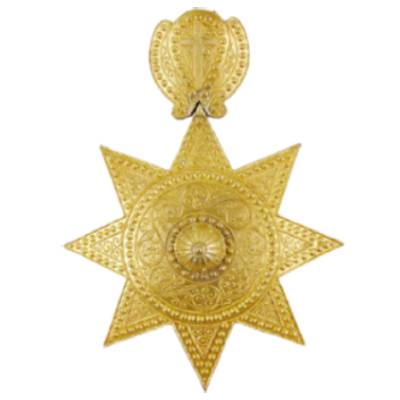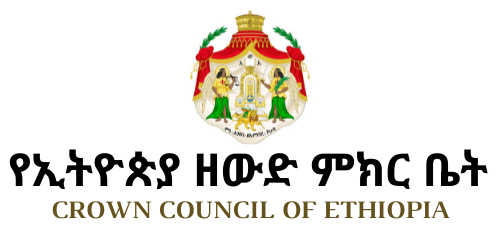
The Order of the Star of Honour of Ethiopia was founded by Emperor Menelik II in 1884-85, in his capacity as Negus of Shoa,1Montandon, Dr George. Op Cit. Page 409-410. and before he became Emperor of Ethiopia (in 1889). It is one of the older awards in the Imperial pantheon. It was originally awarded, according to Montandon, in five levels, plus une catégorie speciale. However, at that time, it was listed as being in three classes, with two sub-grades. The First Class was the Grand Cross; the Second Class grade of Grand Officer was Second Class avec plaque; the Second Class grade of Commander, was without the plaque; the Third Class grade of Officer was with rosette; the Third Class grade of Chevalier (or Member, in the English parlance) was without the rosette. It would seem that there was a conscious effort at the time to emulate the French structure as indicated by the Legion d’Honneur.
Domenico Guadagnini, in his Storia degli Ordini Vigenti ed Estinti, noted that the five grades of the Order were named as: Negus (Knight Grand Cross, for sovereigns); Ras (Knight Grand Officer, for princes); Dje Asmache (Knight Commander); Kague Asmache (Knight Officer); and Gra Asmache (Knight) [Guadagnini’s spellings]. He also noted that the insignia of a Knight Officer, worn on the breast, showed a five-pointed star, joined across the bottom, similar to the emblem in the medal of the rank of Member of the Order today, but without the circular medal surrounding it. The insignia for Knight Officer was suspended from what he called “a characteristic Ethiopian coronet” which was, in fact, a Europeanised coronet, with the riband attached through a loop atop the coronet. The insignia of a Knight Commander, suspended from a neck riband, showed an eight-pointed star in white gold, again surmounted by the coronet and a loop for the riband.2Guadagnini, Domenico: Storia Degli Ordini Vigenti ed Estinti. Italy. It seems likely that the Order was originally given to Ethiopian recipients in the ranks suggested by Guadagnini, although the protocol and the insignia have changed somewhat today. The medal for the grade of Member of the Order of the Star (shown below) is far more simple than before. The Knight Grand Cross version, shown below, which was the one awarded to the Duke of Harar, is, although now Westernised, far more elaborate, of a pattern similar to the original design. The Grand Cross level uses the much more complex star as its motif.
The Order of the Star of Honour of Ethiopia has been awarded sparingly, but to notable Imperial and military figures, such as HH Prince Ras Kassa Hailu, a lifelong friend of Emperor Haile Selassie and a key figure in the Imperial Ethiopian Army, who was presented the Order in its highest form of Knight Grand Cross and Collar; and HH Prince Ras Asserate Kassa, who served as a Colonel in the Imperial Army, as governor-general of various regions, and as Vice-President and President of the Senate (awarded the Order of Knight Grand Cross of the Star of Honour).3Burke’s Royal Families of the World, Vol. II. Op Cit.
Recipients of the Grand Cross of the Order included Ambassador Phaidon Anninos-Kavallieratos, the Greek Chief of Protocol, and Amb. Panayotis Rellas, Greek Ambassador to Addis Ababa, during the visit by Emperor Haile Selassie to Greece in 1959.4Greek Ministry of Foreign Affairs Protocol Department archives. Earlier, in 1955, four Greek officials, three of them from the Army, were made Officer, Commander and Knights, respectively of the Order. In recent years, since the revolution, The Order of the Star of Honour of Ethiopia has continued to be awarded, including the Award to Maj.-Gen. Stanhope S. Spears, for example, of the United States, for his efforts to aid the cause of the Crown.
The Order still comprises five grades: Knight Grand Cross, Grand Officer, Commander, Officer and Member. It is no longer awarded with Collar. In its earlier incarnations, under Emperors Menelik and Haile Selassie, some Grand Crosses were jewel embellished when given to foreign dignitaries. Arthus-Bertrand, in Paris, currently makes the Order.
The design of the Order is in the Ethiopian traditional filigree pattern, based on the shield. The Order has never been enamelled, and some original pieces were solid gold. The Order was originally made in Ethiopia by B. A. Sevadjian of Addis Ababa. During the Emperor’s exile in England, the Order was made by Mappin & Webb (1936-41) in London.
The riband of the Order is in equal thirds of the tricolour: (from right) red, yellow and green. The original riband, when the order was created, was in equal vertical stripes of blue, yellow, green and red,5Montandon, Op Cit. Page 412. but were replaced, probably before the turn of the century, by the national tricolour.
Sir Wilfred Thesiger received the Order with the rank of Commander from Emperor Haile Selassie in 1930, when he attended the coronation. Emperor Amha Selassie I awarded the Order of the Star quite liberally during the 1980s.
Holders of the various grades of the Order may identify themselves by the use of the post-nominal initials: GCSE (Grand Cross), GOSE (Grand Officer), CSE (Commander), OSE (Officer), MSE (Member).


